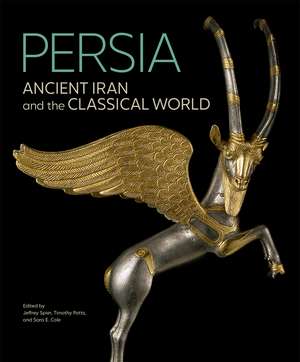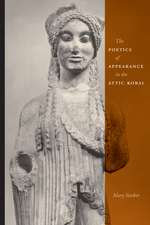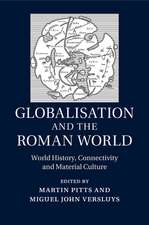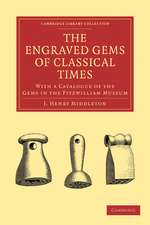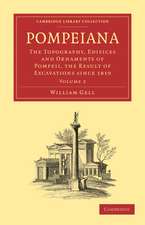Persia – Ancient Iran and the Classical World
Autor Jeffrey Spier, Timothy Potts, Sara E. Coleen Limba Engleză Hardback – 7 apr 2022
The founding of the first Persian Empire by the Achaemenid king Cyrus the Great in the sixth century BCE established one of the greatest world powers of antiquity. Extending from the borders of Greece to northern India, Persia was seen by the Greeks as a vastly wealthy and powerful rival and often as an existential threat. When the Macedonian king Alexander the Great finally conquered the Achaemenid Empire in 330 BCE, Greek culture spread throughout the Near East, but local dynasties—first the Parthian (247 BCE–224 CE) and then the Sasanian (224–651 CE)—reestablished themselves. The rise of the Roman Empire as a world power quickly brought it, too, into conflict with Persia, despite the common trade that flowed through their territories.
Persia addresses the political, intellectual, religious, and artistic relations between Persia, Greece, and Rome from the seventh century BCE to the Arab conquest of 651 CE. Essays by international scholars trace interactions and exchanges of influence. With more than three hundred images, this richly illustrated volume features sculpture, jewelry, silver luxury vessels, coins, gems, and inscriptions that reflect the Persian ideology of empire and its impact throughout Persia’s own diverse lands and the Greek and Roman spheres.
This volume is published to accompany an exhibition on view at the J. Paul Getty Museum at the Getty Villa from April 6 to August 8, 2022.
Preț: 412.58 lei
Preț vechi: 448.46 lei
-8% Nou
78.96€ • 83.06$ • 65.88£
Carte disponibilă
Livrare economică 19 decembrie 24 - 02 ianuarie 25
Livrare express 04-10 decembrie pentru 111.05 lei
Specificații
ISBN-10: 1606066803
Pagini: 432
Ilustrații: 409 color and 7 b-w illustrations, 3 maps
Dimensiuni: 248 x 296 x 38 mm
Greutate: 2.72 kg
Editura: Yale University Press
Recenzii
“In Persia: Ancient Iran and the Classical World, leading experts offer an up-to-date, highly interesting overview of the great epochs Iran experienced under the Achaemenid, Arsacid, and Sasanian dynasties. These key periods in Iranian history become palpable to a substantial extent in the political and cultural encounter with classical Greece, the Seleucid kingdom, and the Roman Empire. The different perspectives with which the individual authors look at the history and material culture open up many new perspectives, even for the specialist. The catalogue’s illustrations make the complexity of the tradition impressively visible.”
—Dr. Bruno Jacobs, Professor Emeritus, University of Basel
Notă biografică
Jeffrey Spier is Anissa and Paul John Balson II Senior Curator of Antiquities at the J. Paul Getty Museum.
Timothy Potts is Maria Hummer-Tuttle and Robert Tuttle Director of the J. Paul Getty Museum.
Sara E. Cole is assistant curator of antiquities at the J. Paul Getty Museum.
Descriere
A fascinating study of Persia’s interactions and exchanges of influence with ancient Greece and the Roman Empire.
The founding of the first Persian Empire by the Achaemenid king Cyrus the Great in the sixth century BCE established one of the greatest world powers of antiquity. Extending from the borders of Greece to northern India, Persia was seen by the Greeks as a vastly wealthy and powerful rival and often as an existential threat. When the Macedonian king Alexander the Great finally conquered the Achaemenid Empire in 330 BCE, Greek culture spread throughout the Near East, but local dynasties—first the Parthian (247 BCE–224 CE) and then the Sasanian (224–651 CE)—reestablished themselves. The rise of the Roman Empire as a world power quickly brought it, too, into conflict with Persia, despite the common trade that flowed through their territories.
Persia addresses the political, intellectual, religious, and artistic relations between Persia, Greece, and Rome from the seventh century BCE to the Arab conquest of 651 CE. Essays by international scholars trace interactions and exchanges of influence. With more than three hundred images, this richly illustrated volume features sculpture, jewelry, silver luxury vessels, coins, gems, and inscriptions that reflect the Persian ideology of empire and its impact throughout Persia’s own diverse lands and the Greek and Roman spheres.
This volume is published to accompany an exhibition on view at the J. Paul Getty Museum at the Getty Villa from April 6 to August 8, 2022.
